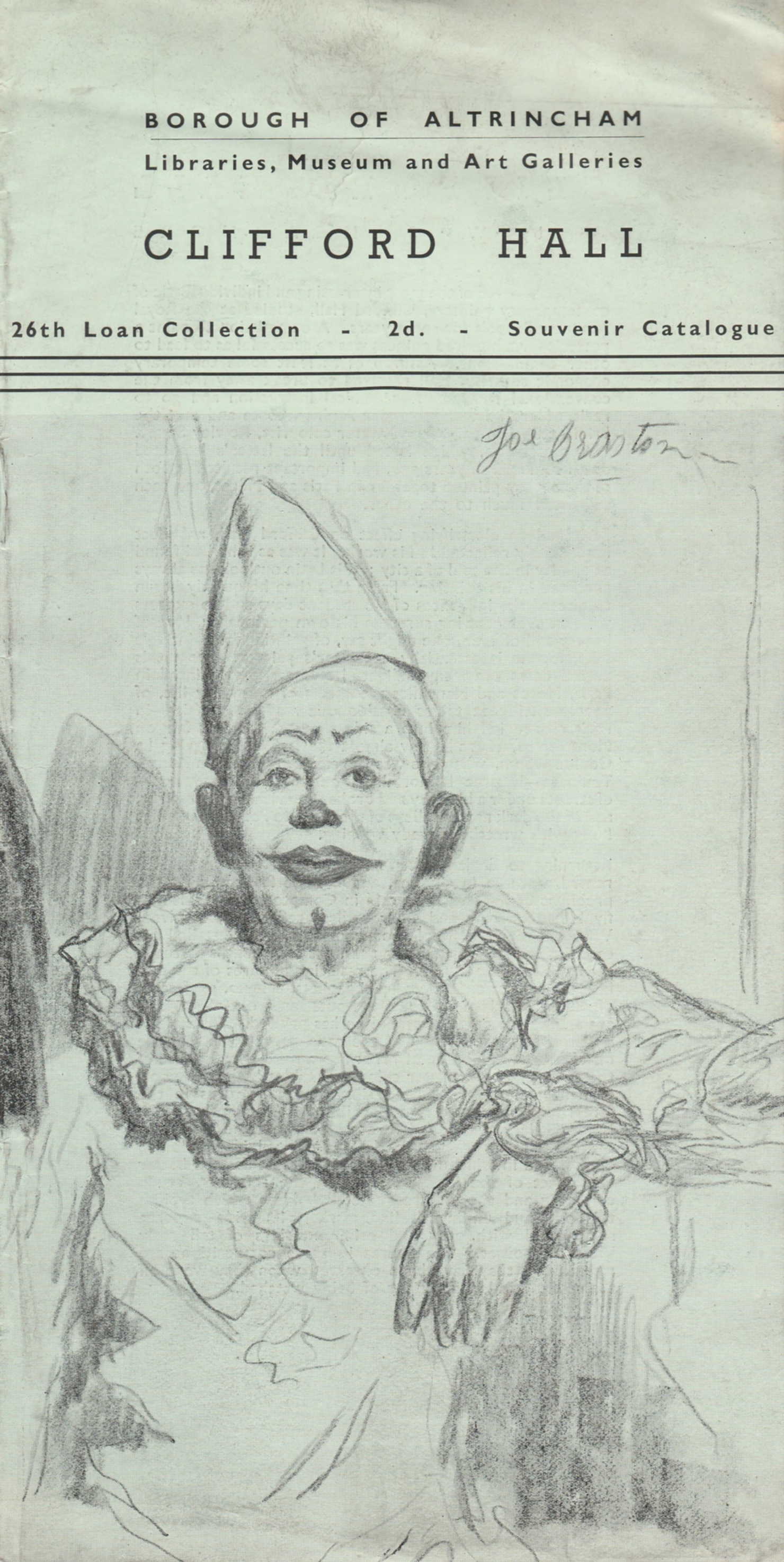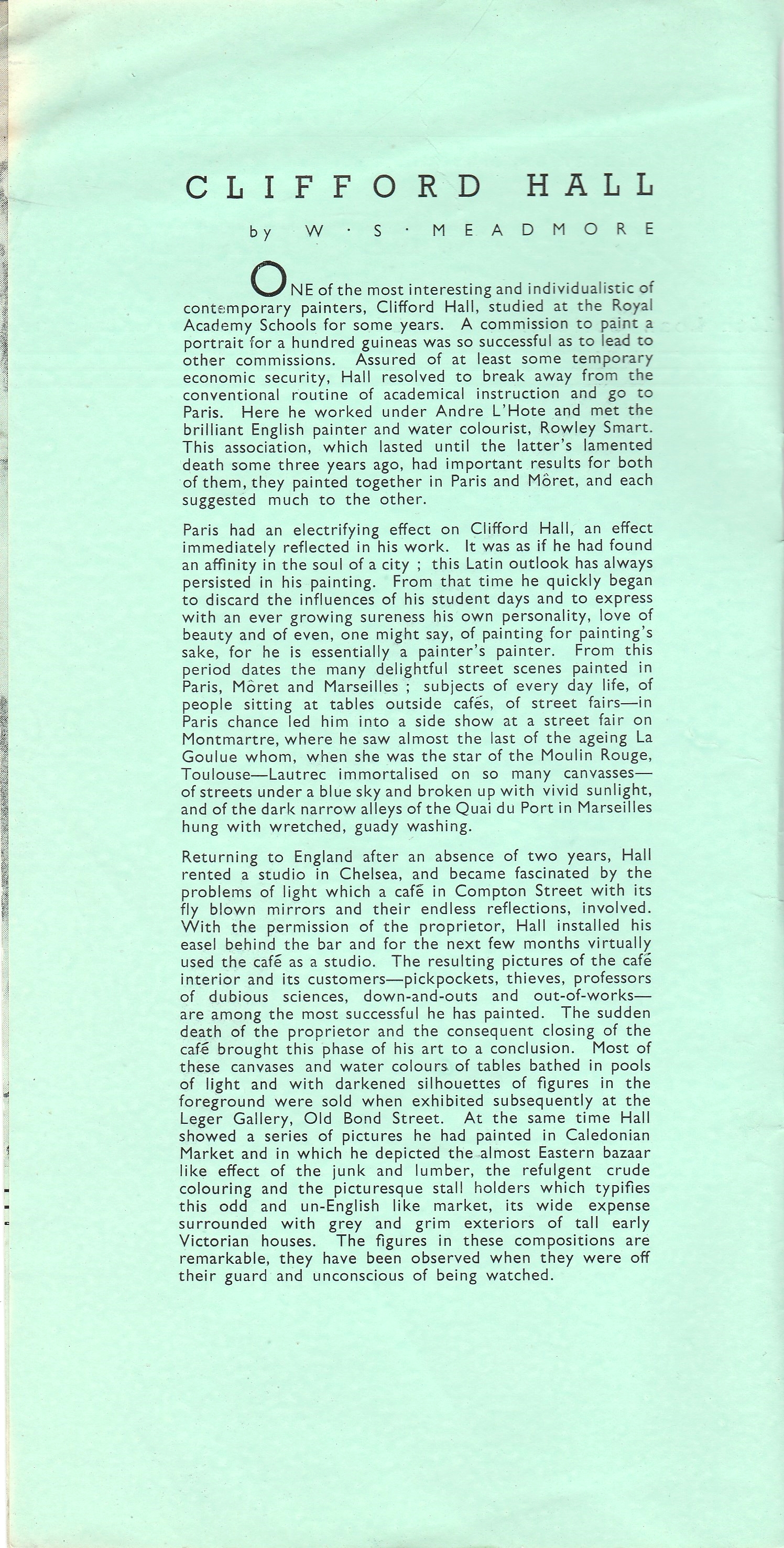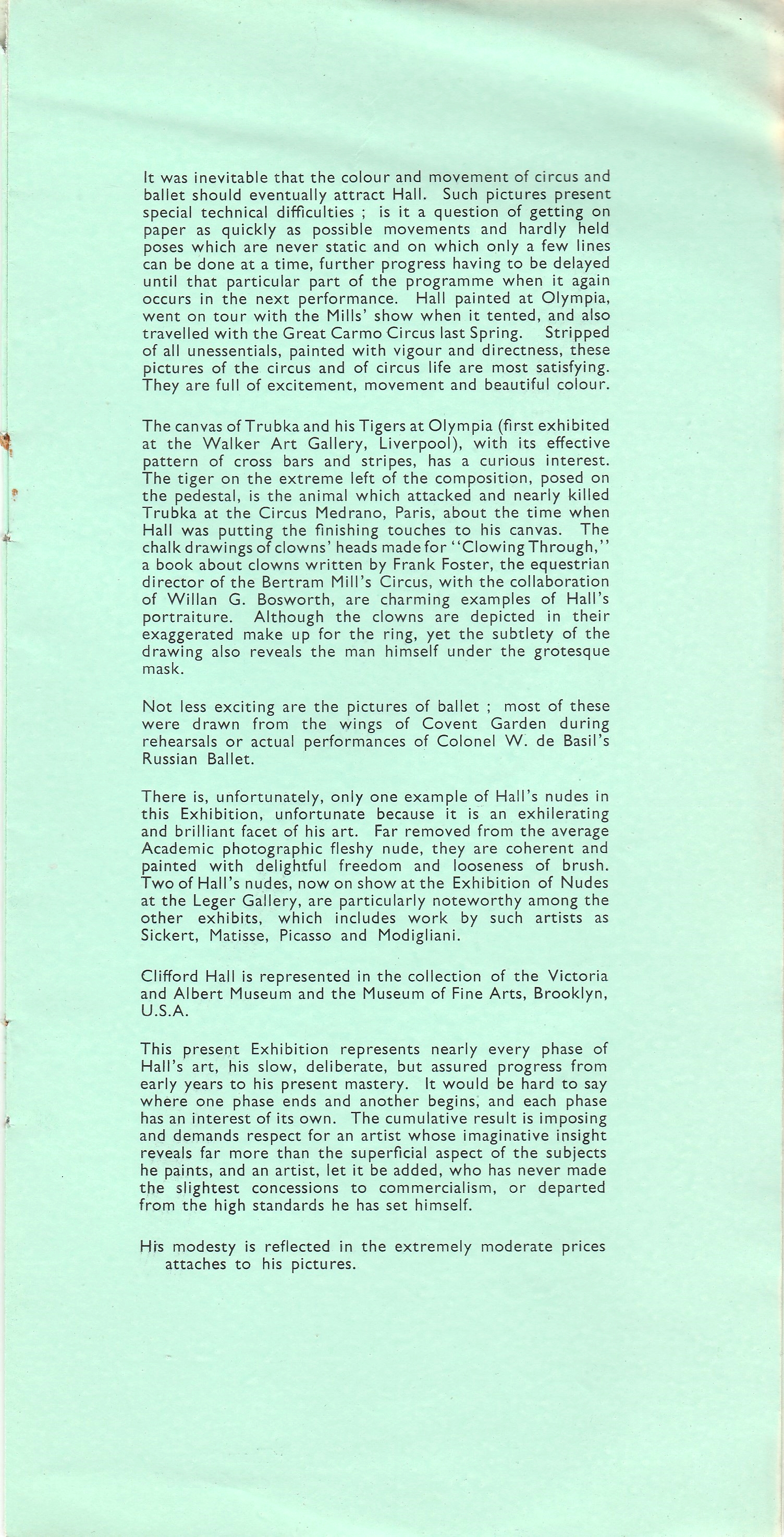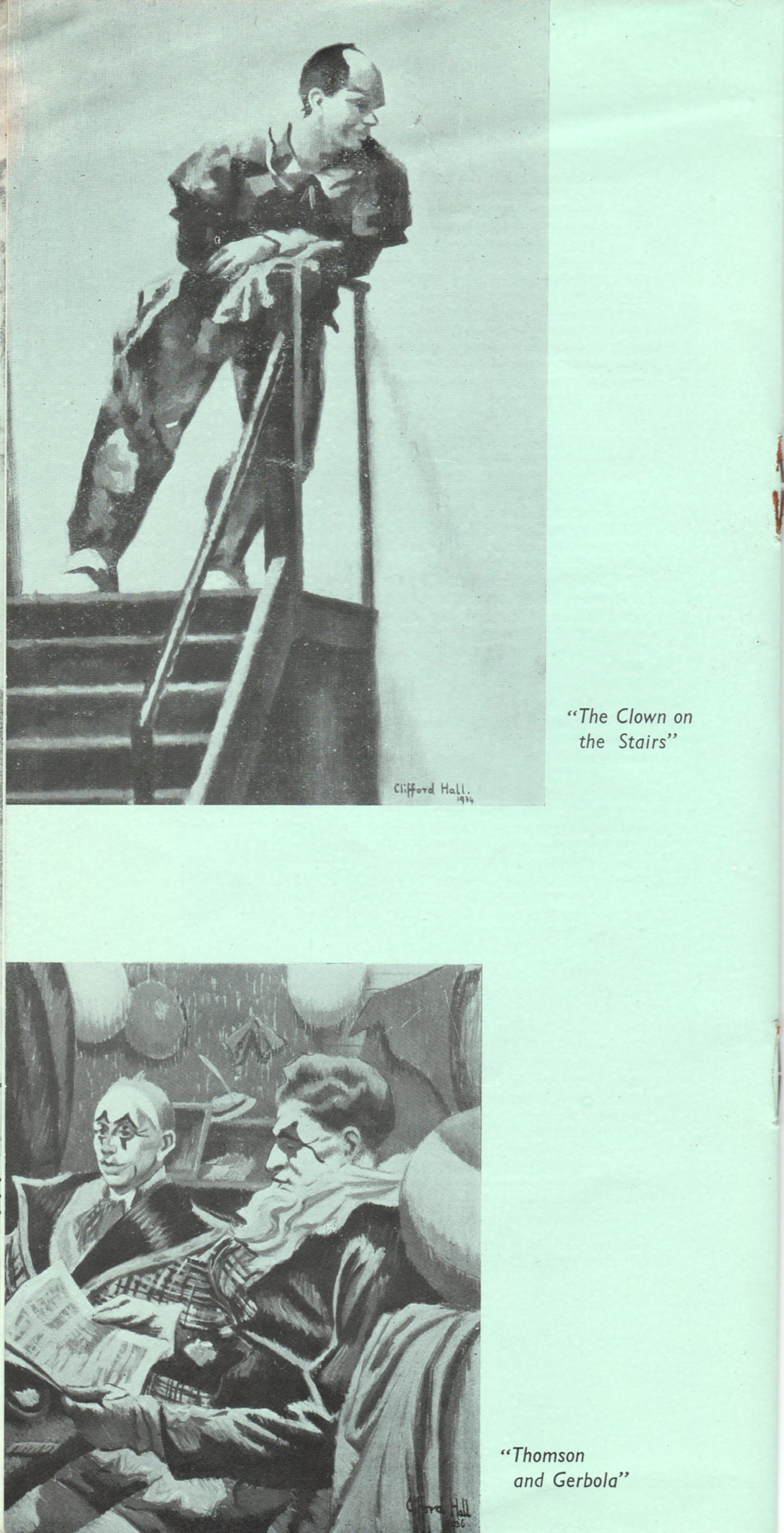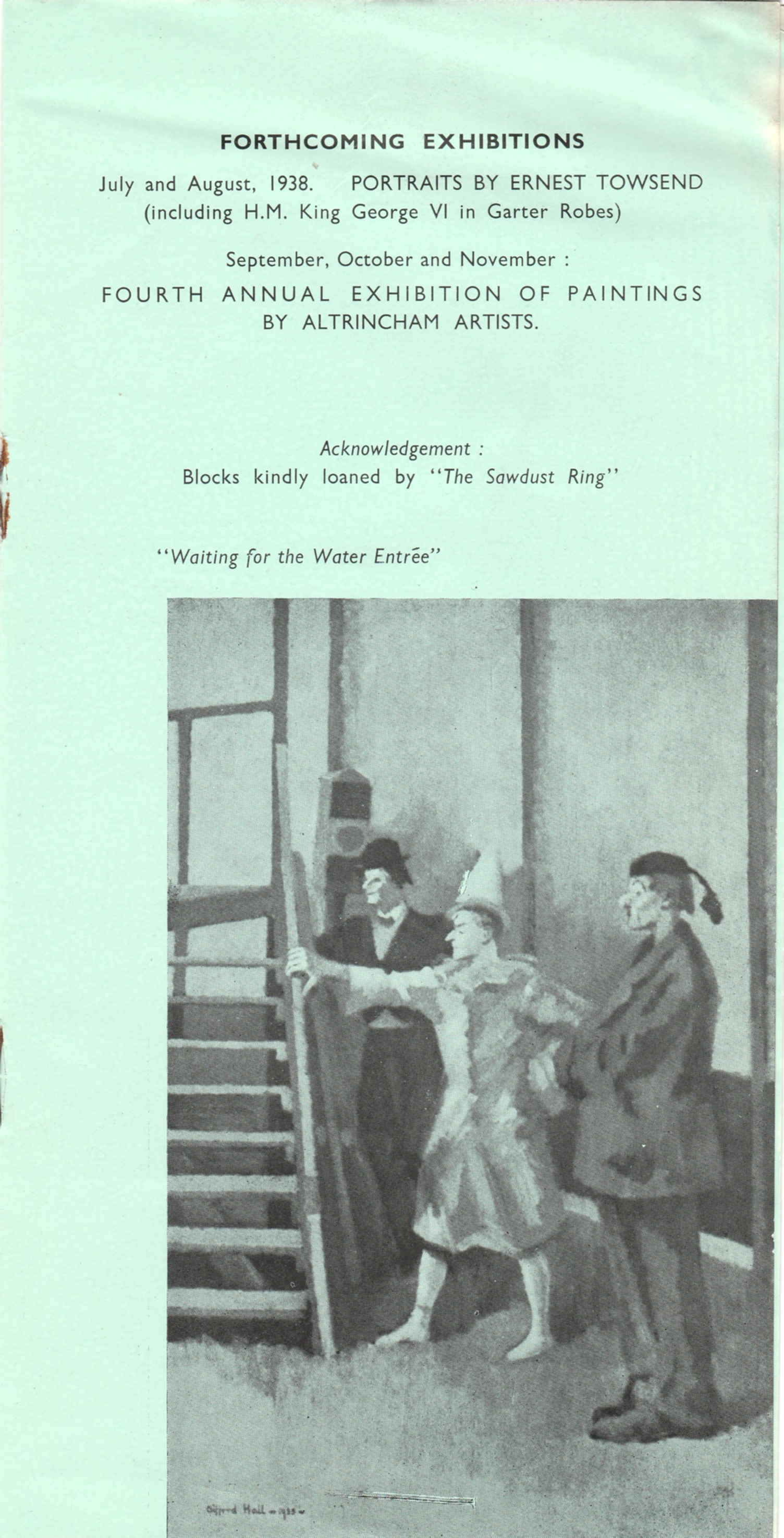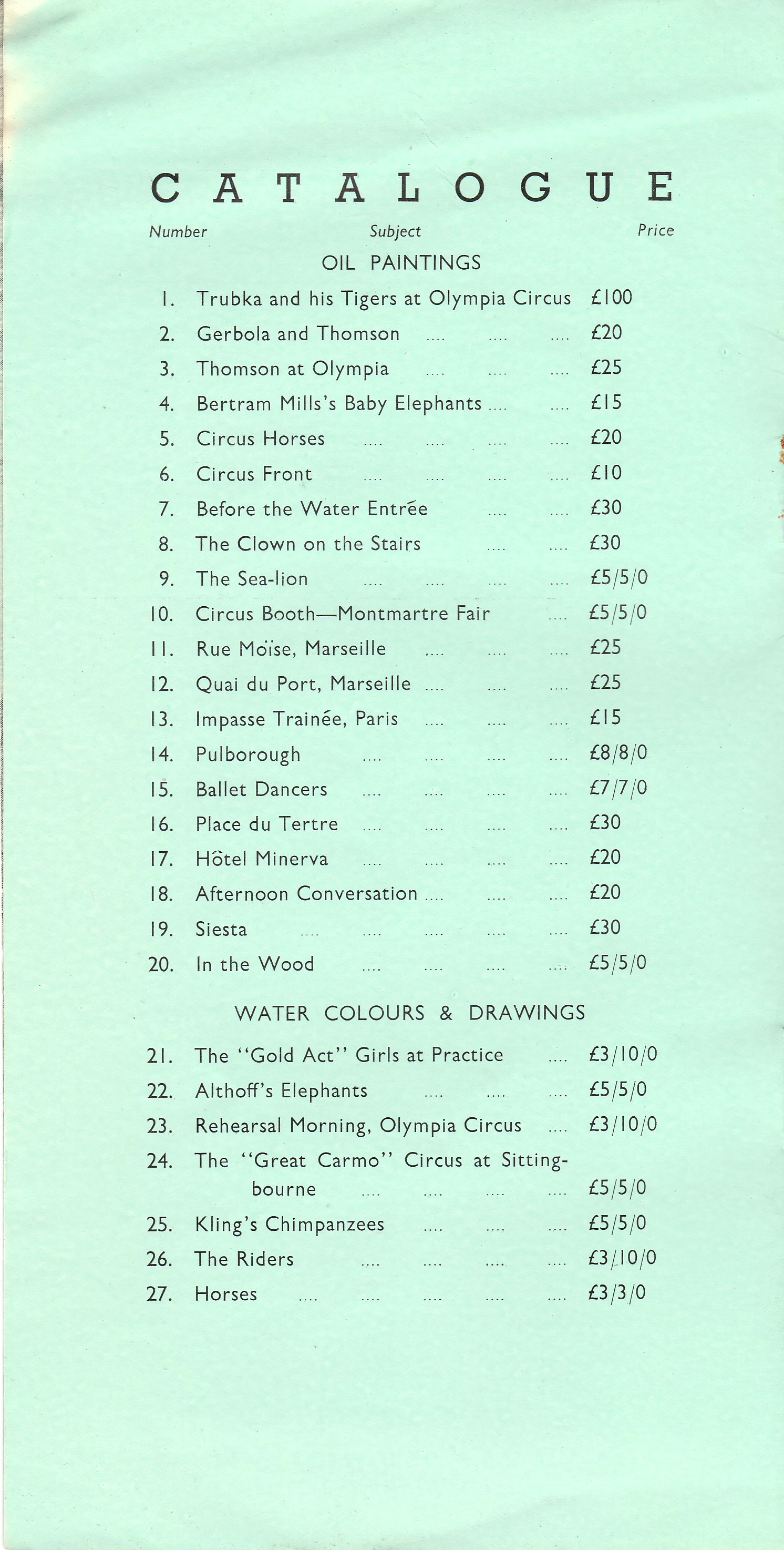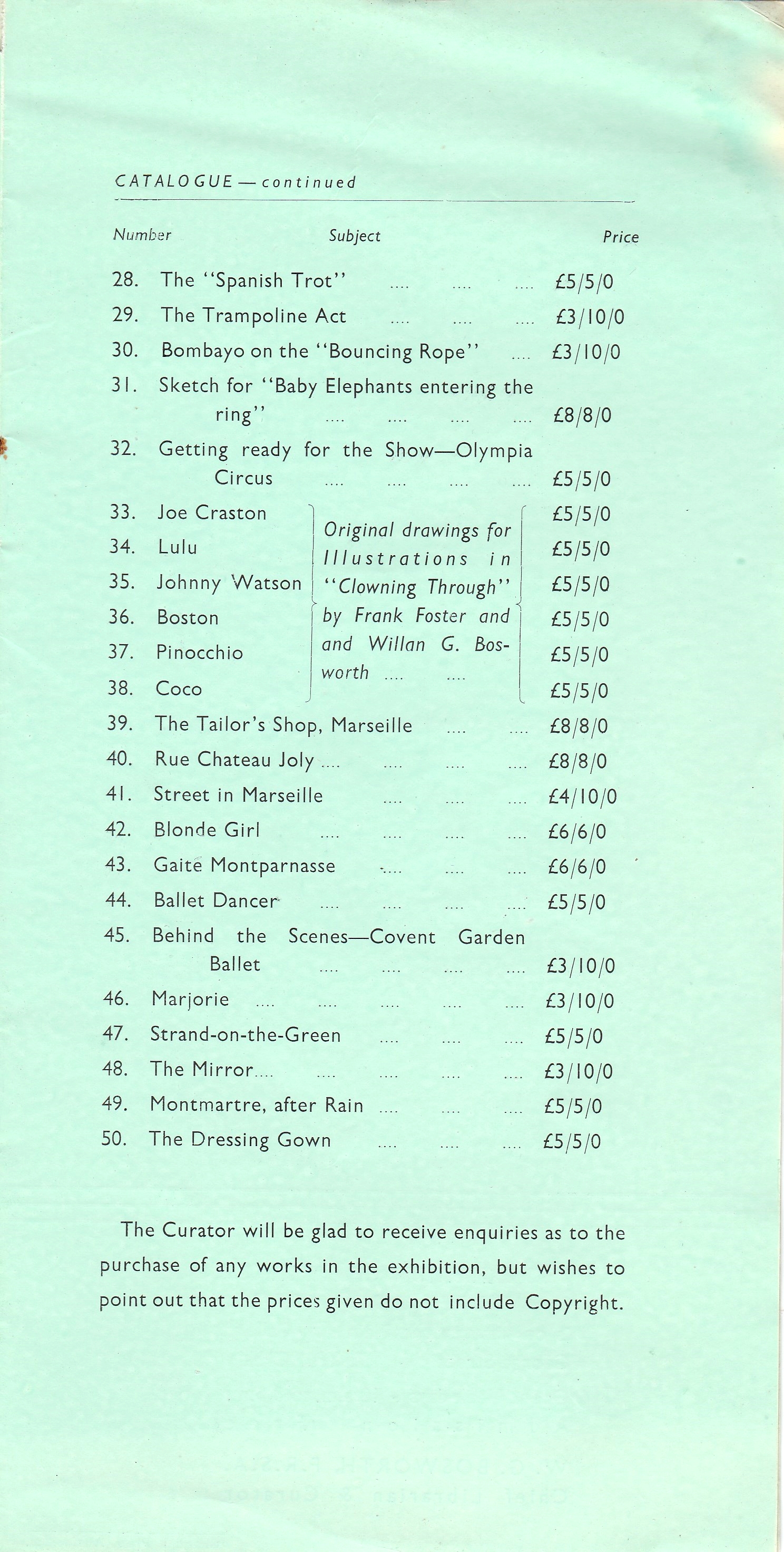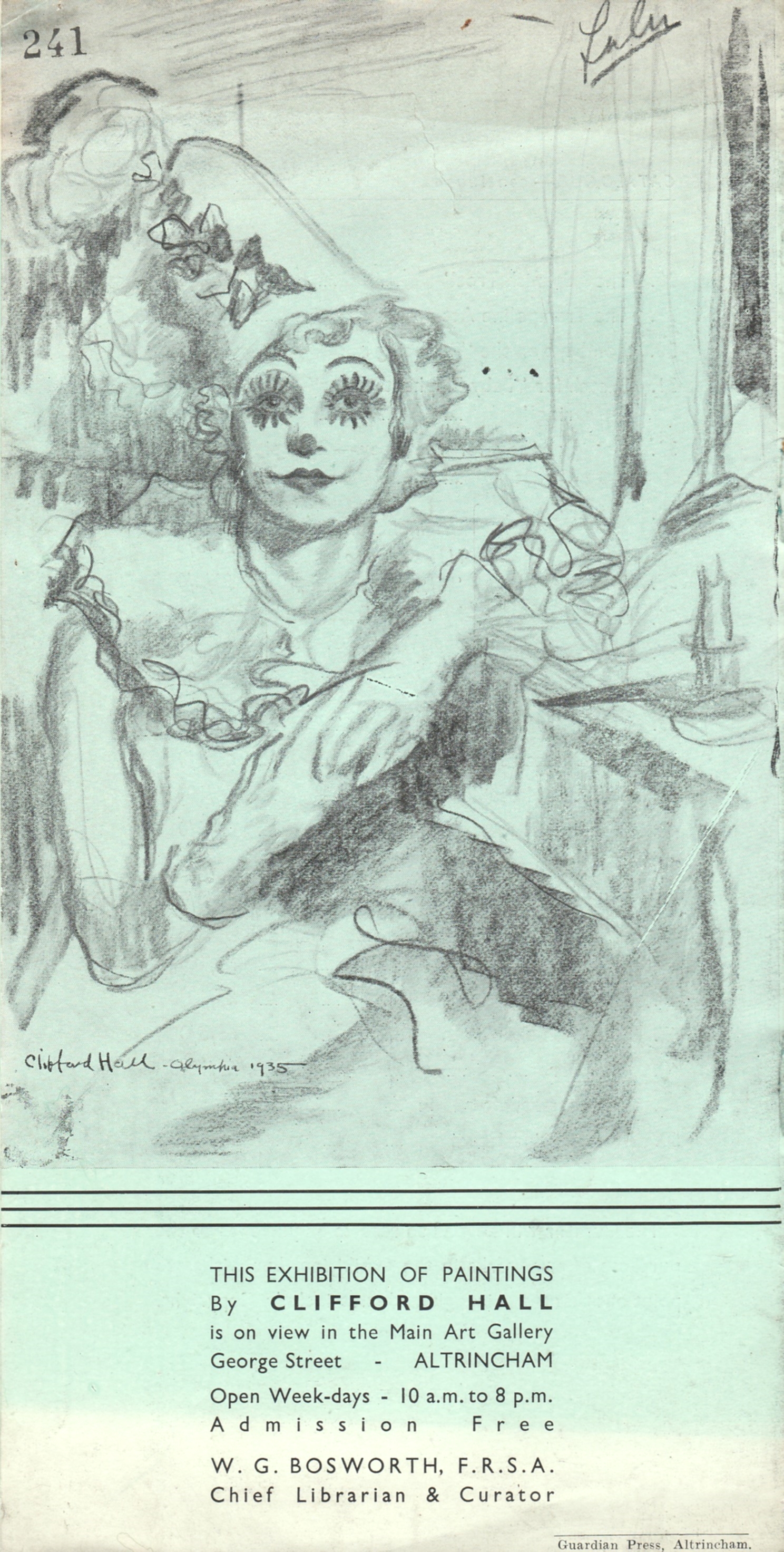
EXHIBITIONS
Clifford Hall Exhibition of Oil Paintings, Water Colours & Drawings' with a foreword by W.S. Meadmore
Clifford Hall's fifth solo exhibition was held at the Main Art Gallery, George Street, Altrincham, Cheshire, England in 1938

- Trubka and his Tigers at Olympia Circus
- Gerbola and Thomson
- Thomson at Olympia
- Bertram Mills's Baby Elephants
- Circus Horses
- Circus Front
- Before the Water Entrée
- The Clown on the Stairs
- The Sea-lion
- Circus Booth - Montnartre Fair
- Rue Moïse, Marseille
- Quai de Port, Marseille
- Impasse Trainée, Paris
- Pulborough
- Ballet Dancers
- Place du Tertre
- Hôtel Minerva
- Afternoon Conversation
- Siesta
- In the Wood
Water Colours & Drawings
- The "Gold Act" Girls at Practice
- Althoff's Elephants
- Rehearsal Morning, Olympia Circus
- The "Great Garmo" Circus at Sittingbourne
- KIng's Chimpanzees
- The Riders
- Horses
- The "Spanish Trot"
- The Trampoline Act
- Bombayo on the "Bouncing Rope"
- Sketch for "Baby Elephants entering the ring"
- Getting ready for the Show - Olympia Circus
Original drawings for "Clowning Through" by Frank Foster and Willan G. Bosworth
- Joe Craston
- Lulu
- Johnny Watson
- Boston
- Pinocchio
- Coco
- The Taylor's Shop, Marseille
- Rue Chateau Joly
- Street in Marseille
- Blonde Girl
- Gaite Montparnasse
- Ballet Dancer
- Behind the Scenes - Covent Garden Ballet
- Marjorie
- Strand-on-the-Green
- The Mirror
- Montmartre, after Rain
- The Dressing Gown
Catalogue Pages
Clifford Hall
by
W S Meadmore
One of the most interesting and individualistic painters, Clifford Hall, studied at the Royal Academy Schools for some years. A commission to paint a portrait for a hundred guineas was so successful as to lead to other commissions. Assured of at least some temporary economic security, Hall resolved to break away from the conventional routine of academical instruction and go to Paris. Here he worked under André Lhote and met the brilliant English painter and water colourist, Rowley Smart. This association, which lasted until the latter's lamented death some three years ago had important results for both of them, they painted together in Paris and Moret, and each suggested much to the other.
Paris had an electrifying effect on Hall, an effect immediately reflected in his work. It was as if he had found an affinity in the soul of the city; this Latin outlook has always persisted in his painting. From that time he quickly began to discard the influences of his student days and to express with an ever growing sureness his own personality, his love of beauty and even, one might say, of painting for painting's sake, for he is essentially a painter's painter. From this period dates the many delightful street scenes painted in Paris, Moret and Marseilles; subjects of everyday life, of people sitting at tables outside cafés, of street fairs - in Paris chance led him into a side show at a street fair on Montmartre, where he saw almost the last of the ageing La Goulue whom, when she was a star at the Moulin Rouge Toulouse-Lautrec immortalised on so many canvases - of streets under blue sky and broken up with vivid sunlight, and of dark narrow alleys of the Quai du Porte in Marseilles hung with wretched, gaudy washing.
Returning to England after an absence of two years, Hall rented a studio in Chelsea, and became fascinated by the problems of light which a café in Compton Street with its fly blown mirrors and their endless reflection, involved. With the permission of the proprietor, Hall installed his easel behind the bar and for the next few months virtually used the café as his studio. The resulting pictures of the café interior and its customers - pickpockets, thieves, professors of dubious sciences, down-and-outs and out-of-works - are among the most successful he has painted. The sudden death of the proprietor and the consequent closing of the café brought this phase of his art to a conclusion. Most of these canvases and water colours of tables bathed in pools of light and with darkened silhouettes of figures in the foreground were sold when exhibited subsequently at the Leger Gallery, Old Bond Street. At the same time Hall showed a series of pictures he had painted in Caledonian Market and in which he depicted the almost Eastern bazaar effect of the junk and lumber , the refulgent crude colouring and the picturesque stall holders which typifies this odd and un-English like market, its wide expanse surrounded with grey and grim exteriors of tall early Victorian hoses . The figures in the compositions are remarkable, they have been observed when they were off their guard and unconscious of being watched.
It was inevitable that the colour and movement of the circus and ballet should eventually attract Hall. Such pictures present special technical difficulties; it is a question of getting on paper as quickly as possible movements and hardly held poses which are never static and on which only a few lines can be done at a time, further progress having to be delayed until that particular part of the programme when it again occurs in the next performance. Hall painted at Olympia, went on tour with the Mills' show when it tented, and also travelled with the Great Carmo Circus last Spring. Stripped of all; unessentials, painting with vigour and directness, these pictures of the circus life are most satisfying. They are full of excitement, movement, and beautiful colour.
The canvas of Trubka and his Tigers at Olympia (first exhibited at the Walker Gallery, Liverpool) with its effective pattern of cross bars and stripes, has a curious interest. The tiger on the extreme left of the composition, posed on the pedestal, is the animal which attacked and nearly killed Trubka at the Circus Medrano, Paris, about the time Hall was putting the finishing touches to the canvas. The chalk drawings of clown' heads made for "Clowning Through," a book about clowns written by Frank Foster, the equestrian director of the Bertram Mill's Circus, with the collaboration of William G. Bosworth, are charming examples of Hall's portraiture. Although the clowns are depicted in their exaggerated make-up for the ring, yet the subtlety of the drawing also reveals the man himself under the grotesque mask.
Not less exciting are the pictures of the ballet - most of these were drawn from the wings of Covent Garden during rehearsals or actual performances of Colonel W, de Basil's Russian Ballet.
There is, unfortunately, only one example of Hall's nudes in this Exhibition, unfortunate because it is an exhilarating and brilliant facet of his art. Far removed from the average Academic photographic fleshy nude, they are coherent and painted with delightful freedom and looseness of brush. Two of Hall's nudes, now on show at the Exhibition of Nudes at the Leger Gallery, are particularly noteworthy among the other exhibits, which includes works by such artists as Sickert, Matisse, Picasso and Modigliani.
Clifford Hall is represented in the Victoria and Albert Museum and the Museum of Fine Arts, Brooklyn, U.S.A.
The present Exhibition represents nearly every phase of Hall's art, his slow, deliberate, but assured progress from early years to his present mastery. It would be hard to say where one phase ends and another begins, and each phase has an interest of its own. The cumulative result is imposing and demands respect for an artist whose imaginative insight reveals far more than the superficial aspect of the subjects he paints, and an artist, let it be added, who has never made the slightest concessions to commercialism, or departed from the high standards he has set himself.
His modesty is reflected in the extremely moderate prices attached to his pictures.
£100
£20
£25
£15
£20
£10
£30
£30
£5/5/0
£5/5/0
£25
£25
£15
£8/8/0
£7/7/0
£30
£20
£20
£30
£5/5/0
£3/10/0
£5/5/0
£3/10/0
£5/5/0
£5/5/0
£3/10/0
£3/3/0
£5/5/0
£3/10/0
£3/10/0
£8/8/0
£5/5/0
£5/5/0
£5/5/0
£5/5/0
£5/5/0
£5/5/0
£5/5/0
£8/8/0
£8/8/0
£4/10/0
£6/6/0
£6/6/0
£5/5/0
£3/10/0
£3/10/0
£5/5/0
£3/10/0
£5/5/0
£5/5/0

Picture Details:
The exhibition consisted of 20 oil paintings and 30 water colours & drawings:
sizes were not included in the catalogue; prices were.
Oil Paintings
